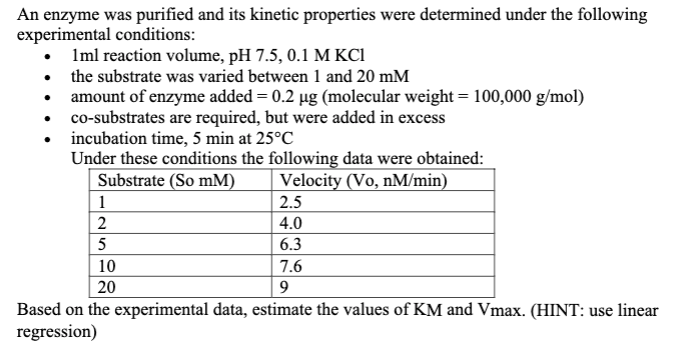An enzyme was purified and its kinetic properties were determined under the following experimental conditions: • 1ml reaction volume, pH 7.5, 0.1 M KCI • the substrate was varied between 1 and 20 mM • amount of enzyme added = 0.2 µg (molecular weight = 100,000 g/mol) co-substrates are required, but were added in excess incubation time, 5 min at 25°C Under these conditions the following data were obtained: Substrate (So mM) Velocity (Vo, nM/min) 2.5 4.0 6.3 10 7.6 20 9 Based on the experimental data, estimate the values of KM and Vmax. (HINT: use linear regression) 1 2 5
An enzyme was purified and its kinetic properties were determined under the following experimental conditions: • 1ml reaction volume, pH 7.5, 0.1 M KCI • the substrate was varied between 1 and 20 mM • amount of enzyme added = 0.2 µg (molecular weight = 100,000 g/mol) co-substrates are required, but were added in excess incubation time, 5 min at 25°C Under these conditions the following data were obtained: Substrate (So mM) Velocity (Vo, nM/min) 2.5 4.0 6.3 10 7.6 20 9 Based on the experimental data, estimate the values of KM and Vmax. (HINT: use linear regression) 1 2 5
Introduction to Chemical Engineering Thermodynamics
8th Edition
ISBN:9781259696527
Author:J.M. Smith Termodinamica en ingenieria quimica, Hendrick C Van Ness, Michael Abbott, Mark Swihart
Publisher:J.M. Smith Termodinamica en ingenieria quimica, Hendrick C Van Ness, Michael Abbott, Mark Swihart
Chapter1: Introduction
Section: Chapter Questions
Problem 1.1P
Related questions
Question

Transcribed Image Text:An enzyme was purified and its kinetic properties were determined under the following
experimental conditions:
• 1ml reaction volume, pH 7.5, 0.1 M KC1
the substrate was varied between 1 and 20 mM
.
amount of enzyme added = 0.2 µg (molecular weight = 100,000 g/mol)
co-substrates are required, but were added in excess
incubation time, 5 min at 25°C
Under these conditions the following data were obtained:
Substrate (So mM)
Velocity (Vo, nM/min)
2.5
4.0
6.3
10
7.6
20
9
Based on the experimental data, estimate the values of KM and Vmax. (HINT: use linear
regression)
1
2
5
Expert Solution
This question has been solved!
Explore an expertly crafted, step-by-step solution for a thorough understanding of key concepts.
This is a popular solution!
Trending now
This is a popular solution!
Step by step
Solved in 2 steps with 2 images

Recommended textbooks for you

Introduction to Chemical Engineering Thermodynami…
Chemical Engineering
ISBN:
9781259696527
Author:
J.M. Smith Termodinamica en ingenieria quimica, Hendrick C Van Ness, Michael Abbott, Mark Swihart
Publisher:
McGraw-Hill Education

Elementary Principles of Chemical Processes, Bind…
Chemical Engineering
ISBN:
9781118431221
Author:
Richard M. Felder, Ronald W. Rousseau, Lisa G. Bullard
Publisher:
WILEY

Elements of Chemical Reaction Engineering (5th Ed…
Chemical Engineering
ISBN:
9780133887518
Author:
H. Scott Fogler
Publisher:
Prentice Hall

Introduction to Chemical Engineering Thermodynami…
Chemical Engineering
ISBN:
9781259696527
Author:
J.M. Smith Termodinamica en ingenieria quimica, Hendrick C Van Ness, Michael Abbott, Mark Swihart
Publisher:
McGraw-Hill Education

Elementary Principles of Chemical Processes, Bind…
Chemical Engineering
ISBN:
9781118431221
Author:
Richard M. Felder, Ronald W. Rousseau, Lisa G. Bullard
Publisher:
WILEY

Elements of Chemical Reaction Engineering (5th Ed…
Chemical Engineering
ISBN:
9780133887518
Author:
H. Scott Fogler
Publisher:
Prentice Hall


Industrial Plastics: Theory and Applications
Chemical Engineering
ISBN:
9781285061238
Author:
Lokensgard, Erik
Publisher:
Delmar Cengage Learning

Unit Operations of Chemical Engineering
Chemical Engineering
ISBN:
9780072848236
Author:
Warren McCabe, Julian C. Smith, Peter Harriott
Publisher:
McGraw-Hill Companies, The